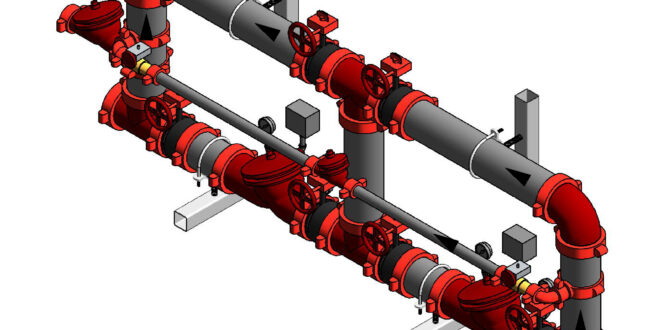Redundancy, Low Flow Bypass and NFPA 14 Acceptance Testing
This blog post contains sponsored content.
As building construction around the world pushes design limits to go higher and further, fire protection systems are challenged by higher water pressures, increased pump capacities and municipal water pressures. To meet code and design requirements for these buildings, hydraulic control valves are used to control downstream pressures, prevent over-pressurization by regulating downstream pressures, and provide safety in relieving excess pressure when required. Understanding how to incorporate hydraulic control valves into system design, commissioning the valves once installed and maintaining the valves for continued functionality, requires an advanced understanding of fire protection.
From a high-rise tower to an aircraft hangar foam system, hydraulic control valves are the key to fire protection systems. Outlined below is a quick guide to successful design, installation, and maintenance of hydraulic control valves.
Master Pressure Reducing Devices
Master pressure-reducing valves are designed to regulate pressures in the entire fire protection system. They are generally located in a riser or fire pump room; to ensure the fire protection system is always protected, master pressure-reducing valve assemblies are designed with redundancy and safety features. Master pressure-reducing valves cannot be direct-acting style valves and must be pilot-operated.
Direct-acting pressure-reducing valves are only listed for single zone fire protection systems, and individual hose valve locations. Direct-acting valves function by reducing the pressure by a set pressure, regardless of the supply pressure. These valves are typically produced in the 2 ½” size.
Pilot-operated pressure-reducing valves function by controlling downstream pressures through modulation of water pressure in the diaphragm by the pilot valve to maintain a constant downstream pressure. Pilot-operated valves are the only type of valves Listed and Approved to be used in master pressure-reducing assemblies.
Redundant Pressure Reducing Valve Design
When a master pressure reducing valve is used to feed the standpipe or combination sprinkler and standpipe riser, they will typically be arranged in a redundant design to support the requirements of NFPA 14. The substantiation for the redundant pressure-reducing valves in series is to ensure there will always be one pressure-reducing valve regulating pressure to the downstream hose valves and other sprinkler system components.
The first pressure reducing valve in the redundant series is set up as the regulating valve. The second pressure reducing valve is setup to only reduce pressure if the first pressure reducing valve fails to open and does not regulate pressure in normal operation. This is the reason behind the normally closed, same sized by-pass line around the redundant pressure reducing valve setup. The normally closed by-pass allows for manually redirecting water around the valve while testing and maintenance is performed.
Master pressure reducing valve assembly designs require the system engineer to verify the correct set points of the pressure reducing valves to achieve their desired downstream pressure at the flow rate in gallons per minute (GPM) for their system design. The engineer/designer will need to verify incoming pressure at both static and designed flow rate. Friction loss through the second pressure reducing valve will also need to be verified with product technical data.
Low Flow By-Pass
Master pressure reducing valve assemblies are often large valves to support the needs of standpipe and sprinkler combined systems. For these combined riser systems, larger flows are required for hose valves, while sprinkler systems are often required to be tested at minimum sprinkler flow (this could be 14.8 gpm, or lower depending on the hazard). When there is minimum sprinkler flow through large pressure reducing valves, it is often very difficult to maintain the valve in a stable open position. When the valves are not able to modulate a sustained opening, they will often “chatter” or constantly open and close creating water hammer that can be detrimental to sprinkler systems. To eliminate “chattering”, a smaller single pressure reducing valve can be implemented as a low flow by-pass line.
Aside from controlling low system flows, the low flow by-pass is key to successfully maintaining pressure increases from the jockey pump. Jockey pumps trying to satisfy downstream pressure through larger pressure reducing valves have a higher chance of component failures due to on and off cycling and water hammers. Using a low flow by-pass around the larger pressure reducing valves will allow the jockey pump to operate more effectively and maintain downstream pressure settings.
NFPA 14 Acceptance Testing
NFPA 14 requires each pressure regulating device to be tested to verify proper installation and operation. The pressure regulating device shall be tested at its maximum design for the system it is serving. This means you must know your maximum GPM and pressure the pressure regulating device needs to be set at.
When pressure reducing devices are set up as an NFPA 14 redundant arrangement, they will need to be tested at four levels.
- The first test will be flow through the first upstream pressure regulating device, around the second pressure-regulating device by means of the by-pass loop and through approved and calibrated testing equipment.
- The second test will be flow through the normally closed by-pass loop around the first upstream pressure-reducing device. Then, flow through the second pressure reducing devices and out to the approved and calibrated testing equipment.
- Next, will test flow through both valves to verify correct operation and design settings.
- The last test is to set and verify your pressure relief valve. This can be done by closing your normally open control valves on the pressure regulating devices and slowing opening the closed by-pass control valves. Slowly bring up the pressure in the downstream system piping until it opens the relief valve at the design set pressure for your system.
*If a low flow by-pass pressure reducing device is installed, this should be set 5 to 7 psi higher than your first pressure reducing device.
Interested in learning more?
Attend the “Pressure-Reducing Devices” seminar hosted by one of our experts at the AFSA41 convention or visit us at booth #300 at the AFSA41 exhibition.
About Victaulic
Since 1919, Victaulic innovation has shaped the course of history and established us as the world leader in pipe-joining and flow control solutions. At the heart of it all is our customers. Our desire to solve their toughest challenges continues to inspire our future.
 Sprinkler Age A Publication of the American Fire Sprinkler Association
Sprinkler Age A Publication of the American Fire Sprinkler Association

